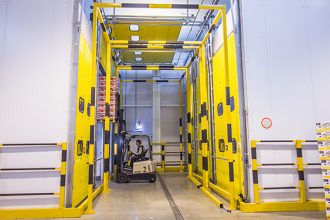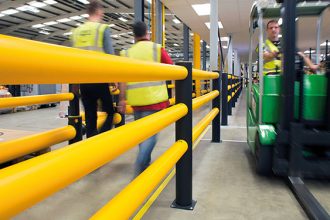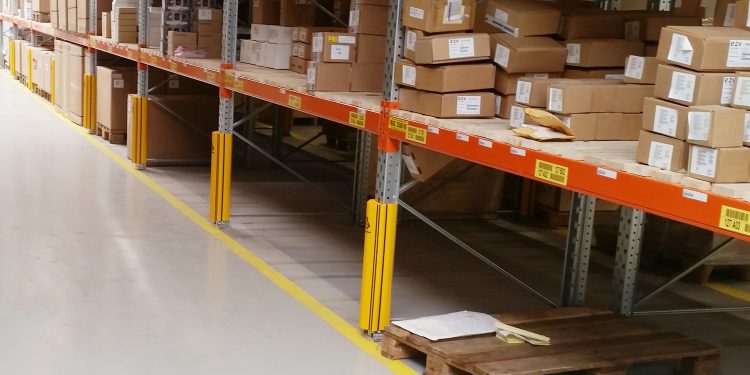
Because of their proximity to forklift traffic, the aisle-side uprights of industrial steel storage racking systems are vulnerable to impacts. Any damage caused by forklift trucks or other moving equipment can significantly reduce the load bearing capacity of the system. This reduced capacity results in an increased risk of collapse—a serious safety concern for facility owners and operators. To reduce the risk, a variety of pallet rack column guards and protective guarding devices are available. Offered as add-ons to new system designs or for aftermarket installation on current systems, they mitigate impact forces on uprights.

Placement Options for Pallet Rack Column Guards
According to Chad Cory, National Account Manager at Steel King Industries—a member of the Rack Manufacturers Institute (RMI)—installation of pallet rack column guards typically occurs in two areas of a system.
“Guarding can be applied to the aisle-side face of the rack column where uprights are vulnerable to impact from an approaching load or reversing vehicle,” he explained. “Also, it can be added to the ends of rack rows to protect corners a vehicle must navigate. They are at higher risk because of the higher traffic entering and exiting aisles. This also includes at cross-aisles and in rack tunnel bays.”
Guidance and best practices for the selection and installation of these protective guarding devices is available from the members of RMI, continued Cory. “RMI lists more than 20 different options in its publication, ‘Considerations for the Planning and Use of Industrial Steel Storage Racks’ in section 3.4.2,” he said.
Cory further noted that the members of the Protective Guarding Manufacturers Association (ProGMA) include several rack protection products engineered to mitigate forklift impacts in the Protective Guarding Search Tool.
Aisle-Side Pallet Rack Column Guards
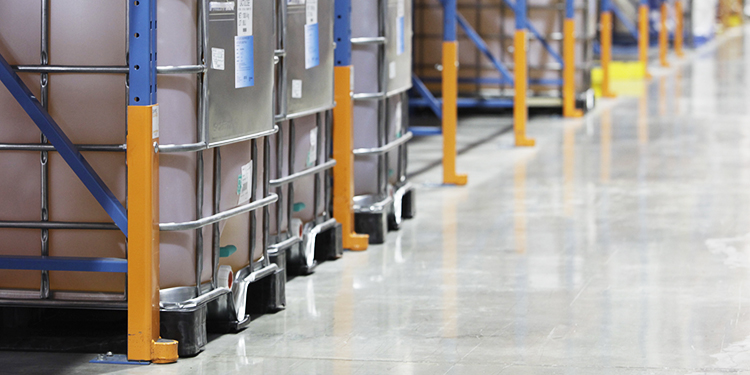
Depending on the needs of the application, pallet rack column guards (also called rack leg protectors) applied to aisle facing uprights come in different materials. They also offer different installation options. These include:
- Free standing column protectors, made of formed steel plates, wrap around the face and sides of the rack column. To secure them, the protectors can be:
- Anchored directly to the floor and not connected to the column.
- Attached to both the column and the floor with bolts and anchors.
- Welded to the columns, typically during manufacturing of the rack system.
- Steel, foam, or flexible polymer guards attached with bolts, rivets, or straps directly to the rack column. Additionally, compression fit guards attach to uprights without fasteners.
Protective Guarding for End of Row Columns
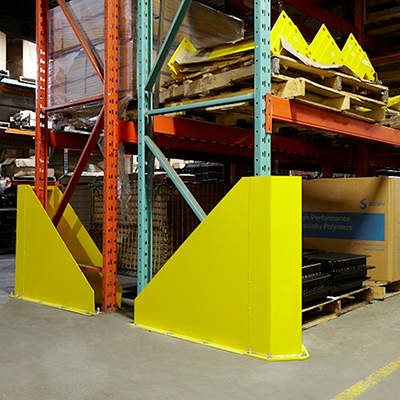
At the ends of rack rows, typical protective guarding devices for columns include:
- Free standing, industrial facility protection guardrail made of steel or polymer materials. These are set a short distance away from the racking and bolted to the floor.
- Heavy, structural steel angles with welded, formed ends that wrap around the rack columns. For installation, the horizontal leg of the angle is pre-punched to accept concrete anchor bolts.
- Formed or welded pipe or tube in an inverted U-shape that run the full depth of the rack assembly. They are typically factory welded to steel base plates and anchored to the floor.
- Flexible polymer pipe or tube anchored to the floor along the full depth of the rack assembly. Typically supplied with spin collars on the end posts, these devices guide a vehicle around the rack as it enters the aisle.
- Guards that attach directly to the sides of the upright frames.
Other Upright Reinforcement Options
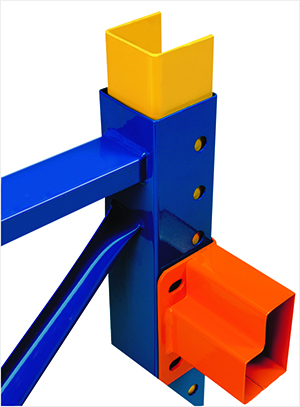 In addition to pallet rack column guards, there are other upright options that can mitigate forklift impact forces. These include:
In addition to pallet rack column guards, there are other upright options that can mitigate forklift impact forces. These include:
- Column doublers, which add a second piece of steel to the aisle-facing uprights. Welded together, this reinforces the column for additional strength and impact resistance
- Column inserts—made of steel or other rigid materials—slid inside the bottom portion of the aisle-facing upright column. Typically installed at the manufacturer, these range from 12 inches to 5 feet tall, increasing the impact resistance of the most vulnerable part of the column.
Considerations When Selecting Pallet Rack Column Guards
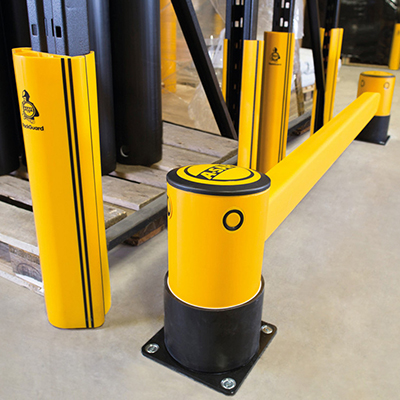 Before investing in pallet rack column guards for the aisle-side or end of a row, Cory advised facility owners and operators to consider the following points when evaluating their options.
Before investing in pallet rack column guards for the aisle-side or end of a row, Cory advised facility owners and operators to consider the following points when evaluating their options.
“Consider how you want to attach the devices. If your operation has restricted aisle widths, such as a very narrow aisle (VNA) layout, anchoring guards in front of the uprights may obstruct traffic,” he said. “It’s important not to impede any handling clearances.”
Other considerations Cory noted included:
- Verifying adequate spacing for the installation of additional anchors for floor-mounted guards.
- Determining the position of load beams to prevent interference from the guarding.
Training forklift operators to exercise caution when navigating around the ends of and through rack aisles is also critical, he added. “While protective guarding for rack uprights will help reduce damage from impacts and potentially improve safety, they are no substitute for properly training operators to operate forklifts with care when loading, unloading, and transporting pallet loads,” Cory said.
Likewise, during routine rack inspections, an assessment of the condition of pallet rack column guards and other protective devices should occur. “Just like damage to the rack system, any damage to the guards should be noted, reported, and promptly repaired,” he concluded.
Want more ideas about the types of equipment available to reduce the risk of pallet rack damage from forklift impacts? Check out ProGMA’s Protective Guarding Search Tool.


